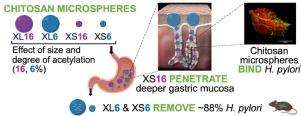Acta Biomaterialia ( IF 9.4 ) Pub Date : 2020-07-01 , DOI: 10.1016/j.actbio.2020.06.035 Patrícia C Henriques 1 , Lia M Costa 2 , Catarina L Seabra 3 , Bernardo Antunes 2 , Ricardo Silva-Carvalho 2 , Susana Junqueira-Neto 4 , André F Maia 5 , Pedro Oliveira 6 , Ana Magalhães 4 , Celso A Reis 7 , Fátima Gartner 8 , Eliette Touati 9 , Joana Gomes 4 , Paulo Costa 10 , M Cristina L Martins 11 , Inês C Gonçalves 1

|
Persistent Helicobacter pylori (H. pylori) infection is related to 90% of gastric cancers. With bacterial resistance rising and treatment inefficiency affecting 15% of the patients, alternative treatments urge. Chitosan microspheres (ChMics) have been proposed as an H. pylori-binding system. This work evaluates ChMics biocompatibility, mucopenetration and capacity to treat H. pylori infection in mice after oral administration. ChMics of different size (XL, ∼120 µm and XS, ∼40 µm) and degree of acetylation (6% and 16%) were developed and revealed to be able to adhere both human and mouse-adapted H. pylori strains without cytotoxicity towards human gastric cells. Ex vivo studies showed that smaller (XS) microspheres penetrate further within the gastric foveolae, suggesting their ability to reach deeply adherent bacteria. In vivo assays showed 88% reduction of infection when H. pylori-infected mice (C57BL/6) were treated with more mucoadhesive XL6 and XS6 ChMics. Overall, ChMics clearly demonstrate ability to reduce H. pylori gastric infection in mice, with chitosan degree of acetylation being a dominant factor over microspheres’ size on H. pylori removal efficiency. These results evidence the strong potential of this strategy as an antibiotic-free approach to fight H. pylori infection, where microspheres are orally administered, bind H. pylori in the stomach, and remove them through the gastrointestinal tract.
Statement of Significance
Approximately 90% of gastric cancers are caused by the carcinogenic agent Helicobacter pylori, which infects >50% of the world population. Bacterial resistance, reduced antibiotic bioavailability, and the intricate distribution of bacteria in mucus and within gastric foveolae hamper the success of most strategies to fight H. pylori. We demonstrate that an antibiotic-free therapy based on bare chitosan microspheres that bind and remove H. pylori from stomach can achieve 88% reduction of infection from H. pylori-infected mice. Changing size and mucoadhesive properties, microspheres can reach different areas of gastric mucosa: smaller and less mucoadhesive can penetrate deeper into the foveolae. This promising, simple and inexpensive strategy paves the way for a faster bench-to-bedside transition, therefore holding great potential for clinical application.
中文翻译:

口服给予的壳聚糖微球可结合幽门螺杆菌并减少小鼠的胃部感染。
持续性幽门螺杆菌(H. pylori)感染与90%的胃癌有关。随着细菌耐药性的提高和无效治疗影响15%的患者,迫切需要替代治疗。壳聚糖微球(ChMics)已被提议作为幽门螺杆菌结合系统。这项工作评估了口服后ChMics的生物相容性,粘膜渗透性和治疗幽门螺杆菌感染的能力。已开发出大小不同(XL,约120 µm,XS,约40 µm)和乙酰化程度(6%和16%)的ChMics,它们能够粘附人和小鼠适应的幽门螺杆菌菌株,而对细胞没有细胞毒性人胃细胞。离体研究表明,较小的(XS)微球在胃小泡内进一步渗透,表明它们能够到达深层附着的细菌。体内试验显示,用更多的粘膜粘附性XL6和XS6 ChMics处理幽门螺杆菌感染的小鼠(C57BL / 6)后,感染减少了88%。总体而言,ChMics清楚地证明了能够降低小鼠幽门螺杆菌胃部感染的能力,其中壳聚糖的乙酰化程度是影响幽门螺杆菌去除效率的微球尺寸的主要因素。这些结果证明了该策略作为抗幽门螺杆菌感染的无抗生素方法的强大潜力,该方法通过口服微球与幽门螺杆菌结合。 在胃中,并通过胃肠道将其除去。
重要声明
大约90%的胃癌是由幽门螺杆菌引起的,该幽门螺杆菌感染了全球50%以上的人口。细菌抵抗力,降低的抗生素生物利用度以及细菌在黏液中和胃小凹中的复杂分布阻碍了大多数对抗幽门螺杆菌的策略的成功。我们证明基于结合和从胃中去除幽门螺杆菌的裸壳聚糖微球的无抗生素疗法可以使幽门螺杆菌感染减少88%感染的小鼠。不断变化的大小和粘膜粘着特性,微球可以到达胃粘膜的不同区域:较小和较少的粘膜粘着剂可以更深地渗入小窝。这种有前途的,简单且廉价的策略为更快的从台式到床的过渡铺平了道路,因此具有巨大的临床应用潜力。











































 京公网安备 11010802027423号
京公网安备 11010802027423号